The main category of Fitness News.
You can use the search box below to find what you need.
The main category of Fitness News.
You can use the search box below to find what you need.
At 37, Samantha Murrell was the picture of health. She hiked daily and enjoyed other outdoor activities like paddleboarding and mountain biking near her home in Montana.
Murrell was also proactive with her health and stayed on top of preventive exams. She diligently checked for moles that could indicate the beginnings of skin cancer, did breast self-exams because of a family history of breast cancer and stayed current with OB-GYN appointments to catch any early signs of reproductive cancers.
In early 2024, Murrell took a trip to India and battled a slight cough and chest pressure when she returned. Although she continued her daily activities, the chest pressure grew uncomfortable after two weeks, and she went to an urgent care clinic for treatment.
An X-ray showed her left lung had collapsed and was full of fluid. She was told to go to the emergency room immediately. After the fluid was drained and tested while she was hospitalized, the results came back as stage 4 lung cancer.
“I was so taken aback when they said I had lung cancer,” Murrell said. “It was the most confusing thing because I’d never been educated that non-smokers could get lung cancer. If I’d been told I had breast, cervical or skin cancer, I would have probably accepted it right away and said, ‘Okay let’s do this,’ but I thought this was the one cancer I just could not get because I didn’t smoke.”
Read: Women Who Have Never Smoked Can Get Lung Cancer >>
While smoking remains the leading risk factor for lung cancer, diagnoses like Murrell’s are becoming more common in non-smokers. Up to 2 out of 10 lung cancers (20,000-40,000 per year) are being diagnosed in people who never smoked or smoked fewer than 100 cigarettes in their lives. Lung cancer is also more likely to occur in people over 65, with 70 being the average age of diagnosis, but younger women are now being diagnosed with lung cancer at higher rates than their male counterparts — especially among non-smokers.
Norman Edelman, M.D., a professor of medicine at Stony Brook University who studies pulmonary diseases, said the answers aren’t clear on why lung cancer rates are increasing among non-smokers, but those exposed to particle pollution face the highest risk.
“Environmental pollutants increase the risk of lung cancer likely the same way as cigarettes, as oxidant chemicals disrupt the cells’ DNA,” Edelman said. “Although research is limited to pollutants which are monitored, fine particles are the most studied and the most implicated.”
While secondhand smoke — exposure to other people’s smoking — can be a factor in lung cancer development, environmental factors such as radon, air pollution, smoke from wildfires and fine particulate matter are increasingly being connected to cases in non-smokers. The Environmental Protection Agency says radon — radioactive gas that seeps into homes — is the top cause of lung cancer in non-smokers, contributing to about 2,900 lung cancer deaths in non-smokers each year.
More research is also connecting genetic factors to lung cancer development, with studies showing how air pollution triggers lung cancer development in cells with certain genetic mutations. While Murrell’s short trip to India likely didn’t cause her lung cancer, she believes the change in air quality and a weakened immune system from the trip triggered the symptoms that led to her diagnosis.
Continuing research into genetic mutations could provide more insight on links between pollution and lung cancer in non-smokers. Murrell said she has the HER2 mutation, which is most common in people with breast cancer, although up to 2% of lung cancer patients have the HER2 mutation. More common cell mutations in lung cancer patients are ALK or EGFR.
Read: Understanding the Different Types of Lung Cancer >>
When Murrell was in the hospital for her initial treatment, she tried to figure out the cause of her cancer. She remembers filling out a questionnaire asking if she’d worked in a factory or lived in an area with high pollution or coal mining — none of which applied. She lived in Iowa for seven years, and read that Iowa had the fastest growing rate of new cancers in the U.S. Could she have been exposed to agricultural-related pollutants years ago?
“I don’t have an answer for my case particularly,” Murrell said. “I was never around secondhand smoke. I was not in a hazardous job. I don’t think I was exposed to radon since I moved a lot and only lived in the same house for about two years my entire life. I just don’t know.”
While anyone can develop lung cancer, people of color — especially women — have worse outcomes from the disease, often because they’re less likely to get an early diagnosis or receive treatment, according to the American Lung Association. This is the case even when they’re experiencing common lung cancer symptoms like a worsening cough, chest pain, shortness of breath, wheezing, coughing up blood and fatigue.
Murrell encourages anyone experiencing those symptoms to see a healthcare provider immediately, although she’s aware of multiple survivors who went years being misdiagnosed. By the time they received a diagnosis, they were at stage 4.
“If you have those symptoms and they’re not going away with just normal treatments, be really persistent and push for more investigation,” she said.
Read: Doctors Shrugged Off My Cough Because I Wasn’t a Smoker — but I Had Stage 4 Lung Cancer >>
Edelman also encourages those eligible to be screened for lung cancer. “CAT scan screening has been successful. Over the past decades, the five-year survival rate from lung cancer has increased,” he said.
To be eligible for annual screening under current U.S. Preventive Services Task Force guidelines, you must be between the ages of 50 and 80, currently smoke or have quit within the past 15 years, and must have a 20 pack-year smoking history. (A pack year is the equivalent of smoking a pack [20 cigarettes] a day, every day for a year. A person could have a 20-pack year history by smoking a pack a day for 20 years or smoking two packs a day for 10 years ). These criteria, however, can leave out a large number of people without risk factors.
Murrell knows of younger women with a family history who were turned down for screening, and she notes how she didn’t have any of the typical lung cancer symptoms that would have led to a provider suggesting a screening. The only early sign she recognizes now was a blood clot in 2023 that HCPs said could be related to birth control use or sitting for long periods of time on another airplane trip. She believes now the clot was likely an early sign of lung cancer.
Today, Murrell and her husband are living in Park City, Utah, where she can be closer to an NCI-Designated Cancer Center for treatment. She calls her life “pretty normal” despite her diagnosis, and she still hikes four miles a day, lifts weights and works full time. She attributes her good health to her lifestyle before her cancer treatment and is thankful she’s able to continue doing the things she enjoys.
She’s also become an advocate with the Young Lung Cancer Initiative, which she found as a source of support while undergoing treatment. On their website and social media, she read multiple stories of people doing well years after a stage 4 diagnosis.
“The Young Lung Cancer Initiative really stood out to me,” she said. “Initially upon my diagnosis at my local hospital, I was given nine months to live, but seeing people’s messages gave me a lot of hope for this journey. I’m so fortunate I found the group so early on.”
This educational resource was created with support from Daiichi Sankyo.
From Your Site Articles
Related Articles Around the Web
As a senior at Florida A&M University, Sharon Harris had been juggling a full course load, three jobs and other demands of college life when she started to feel sick.
She visited the doctor and went to the hospital emergency room for gastrointestinal problems, and healthcare providers (HCPs) thought she might have Crohn’s disease. The medication she received didn’t help, but she powered through to make it to graduation.
When Harris’ mother came to her graduation ceremony, she asked her daughter about the butterfly-like rash on her cheeks and nose. Harris hadn’t noticed, but assumed it was related to stress. She’d ask her HCP in Detroit the next time she went home.
Once home, the provider ordered blood work, which came back positive for markers of discoid lupus and systemic lupus erythematosus (SLE). Harris said she’ll always remember that day — February 4, 2002 — as the moment her life changed.
Since then, Harris has become a local and national advocate for people with lupus, founding Lupus Detroit and working with other organizations to support patients through physical, mental and financial difficulties related to the disease. She continues the work despite her own health struggles, including a 2015 stroke and stage 5 kidney failure.
“Lupus is a very serious autoimmune disease that can lead to other autoimmune diseases, and I’ve been diagnosed with additional ones,” Harris said. “A common problem is that there isn’t a single test that can diagnose lupus, and it’s been reported it takes patients years to get an accurate diagnosis. That’s a long wait when a person’s hair is falling out; their joints and bones are aching; and they’re fatigued, have brain fog and have kidneys that are failing. It takes a toll on a patient’s mental health, finances, body, family life, emotions, work life and social life.”
Systemic lupus erythematosus (SLE) is the most common form of lupus, and the general term “lupus” typically refers to SLE. An autoimmune disease, lupus attacks connective tissue in the body, and it can strike every organ system.
Discoid lupus, the diagnosis Harris received, is a type of lupus called
cutaneous lupus erythematosus (CLE), known mostly for the presence of a “malar rash” or “butterfly rash” on the face. Lupus patients can have both SLE and CLE.
Women make up 9 out of 10 lupus cases, with Black/African American, Native American/Alaska Native and Asian Americans representing 4 out of 10 of the estimated SLE cases in the United States, while Hispanic and Latino patients make up 2 out of 10 cases. Black/African American women with lupus die up to 13 years younger than white women with lupus.
Dr. Joy Buie, M.D., vice president for research with the
Lupus Foundation of America, said there are multiple reasons for high rates of SLE and worse outcomes among people of color.
“When we think about
disparities in general, we have to think about social conditions and the social context in which people live,” Buie said. “We know communities of color have been disenfranchised within the United States, and specifically thinking about Black and African American women, we know those conditions have had negative implications for health. Psychosocial stressors, structural racism, financial disadvantages, economic instability and lack of educational opportunities feed into susceptibility for developing any disease.”
Buie also oversees the foundation’s health equity work, which includes research on lupus and racial health disparities. The foundation cites studies indicating how Black lupus patients were more likely to have negative experiences with healthcare systems, such as
rushed communication and lack of trust in providers, or more difficulty accessing care due to a lack of transportation or insurance or living farther away from specialists. Black people living with lupus were also more likely to lose their jobs after being diagnosed, possibly because of the severity of their disease, which made it harder for them to maintain employment.
While
1 in 5 American women have positive antinuclear antibodies, or ANA — key markers for lupus — not all will develop the disease. Buie cites epigenetics — the way your environment and behavior can affect how your genes work — as having an effect on the development of lupus among women of color.
Lack of sleep, obesity, smoking, viruses and bacteria have also been associated with increased lupus risk, and Buie said some research shows that exposure to
silica, a chemical found in the environment and used in many commercial products like skincare products and cleaners, can be a contributor.
“It’s genetics, it’s hormones, it’s the environment — the intersection of those factors all play a role in developing lupus,” Buie said. “What’s problematic with this disease is that it’s not a visible disease. It’s quite invisible. You can look at a person and not even tell they’re sick. That’s the challenge of living with a disease like lupus.”
As Harris experienced, getting a correct diagnosis can also take time because lupus can show up differently in each individual. One person might have rash and joint inflammation while someone else could have kidney and heart disease. Even after diagnosis, disease management can be challenging if patients don’t have access to the right specialists and treatments as a result of financial concerns, location or lack of education about the disease.
“There is hope”
Buie is optimistic, however, that change could be on the horizon. The Lupus Foundation of America recently launched a project to predict who might get lupus to help prevent it in others. Researchers will follow family members of people with lupus over time to see what changes occur and who eventually develops the disease. The data can then be used to identify at-risk individuals and offer lifestyle changes and treatments to help prevent the disease or stop its progression.
As for Harris, she’s worked hard to not let lupus destroy her dreams. In addition to launching Lupus Detroit, she also worked as a public relations director for the Lupus Alliance of America, Michigan Indiana Affiliate. She earned a master’s degree in public policy and hopes to write a book in the future.
Her advocacy has also taken her places she never imagined. During her tenure at the Autoimmune Association, she testified at an FDA hearing about the high cost of lupus medication. She was tickled by a brief moment of fame when she appeared in an article about rapper Snoop Dogg’s daughter, Cori Broadus, who’s also living with lupus.
“An average day for me involves getting physically stronger,” Harris said. “I use my time researching all things autoimmune disease and looking for additional resources. Just because I have a treacherous disease, it doesn’t mean I want to be complacent and rest on my laurels.”
Although Harris is waiting for a kidney transplant, her advocacy and the work of researchers could deliver a brighter future for those with lupus or those at risk.
“Know there is hope,” Buie said. “There are medications approved by the FDA in the last 20 years to treat lupus, and so many more treatments in the pipeline. There’s even conversation about opportunities for a cure. Lupus doesn’t have to be a death sentence, but the key is to get the right healthcare team in place and find ways to take control of your health.”
This educational resource was created with support from GSK, Merck and Novartis.
From Your Site Articles
Related Articles Around the Web
Attention libation lovers: A new advisory from the surgeon general says drinking alcohol — even one drink a day — increases the risk for certain cancers.
Breast cancer had the highest alcohol-related risk for women and people assigned female at birth. The report states that about 4 more women out of 100 would develop breast cancer by drinking two alcoholic drinks a day. And that’s regardless of the type of alcohol consumed including beer and wine.
The report also links alcohol to an increased risk for six other cancers — colorectal, esophagus, liver, mouth, throat and voice box cancer.
There’s been a growing body of research in recent years pointing to the health risks of drinking alcohol, but now the advisory is taking it one step further, calling for warning labels — Similar to the pregnancy warning already on bottles of alcohol — to be put on bottles to help increase awareness about the link between alcohol and cancer.
Steven Quay, M.D., Ph.D., has spent more than 30 years in medical research focused on breast cancer and preventive therapies. We asked him what women need to know about the surgeon general’s report and the latest research out there regarding the link between alcohol and cancer.
Read: How Much Alcohol Is Too Much for Your Heart Health? >>
The surgeon general’s advisory underscores that even small amounts of alcohol can increase a woman’s risk of cancer, particularly breast cancer. It highlights that breast cancer accounts for the majority of alcohol-related cancer cases among women, with evidence suggesting that risk increases even at levels as low as one drink per day.
This advisory serves as a wake-up call to reevaluate societal norms surrounding alcohol consumption, particularly among women, and to promote awareness that alcohol is a modifiable risk factor for one of the most common cancers affecting women.
Read: My First Dry January Was Overflowing With Criticism, but I Learned to Listen to Myself >>
The evidence suggests that there is no safe level of alcohol consumption when it comes to cancer risk. Both the surgeon general and National Academy reports indicate that alcohol increases cancer risk in a dose-dependent manner, with risk starting to rise even with low levels of consumption. The surgeon general’s report is explicit in stating that the best way to lower cancer risk is to abstain from alcohol entirely. While the National Academy report acknowledges the same association, it also points out that the absolute increase in risk at very low levels may be modest. The public health message is clear: Less is better, and none is best.
Women need to know that alcohol is a significant, preventable risk factor for breast cancer. The surgeon general’s report emphasizes that even one drink per day can increase breast cancer risk by approximately 10%, and consuming two drinks daily raises this risk by over 30%. The mechanism involves alcohol-induced increases in estrogen levels, which can drive the development of hormone-sensitive breast cancers. This reinforces the need for awareness campaigns and a cultural shift in how alcohol is marketed and consumed by women. Women should be empowered with the knowledge that reducing or eliminating alcohol consumption is a proactive step toward lowering their cancer risk.
Yes, it is never too late to reduce your cancer risk by stopping alcohol consumption. The National Academy report notes that ceasing alcohol intake can lead to a gradual reduction in cancer risk over time, as the body begins to repair alcohol-induced DNA damage and hormonal imbalances. Additionally, the surgeon general’s advisory highlights that any reduction in alcohol use, even after years of consumption, can still contribute to improved overall health and decreased risk of alcohol-related cancers. This is particularly important for women who may have consumed alcohol under the misconception of its cardiovascular benefits, which recent evidence has shown to be overstated or outweighed by cancer risks. The key takeaway is that quitting alcohol now is a powerful and actionable step toward improving long-term health outcomes.
From Your Site Articles
Related Articles Around the Web
Maybe while you decked the halls this holiday season you splurged on too much spiked eggnog and Jack Frost martinis, followed up by ringing in the New Year with lots of champagne or perhaps now that you’ve flipped the calendar you are tackling some healthy resolutions, but whether you’re looking to cut down on or cut out your alcohol consumption, you may be considering the health challenge popularly called, dry January. Top dieticians share strategies and tips on how to survive and thrive for Dry January.
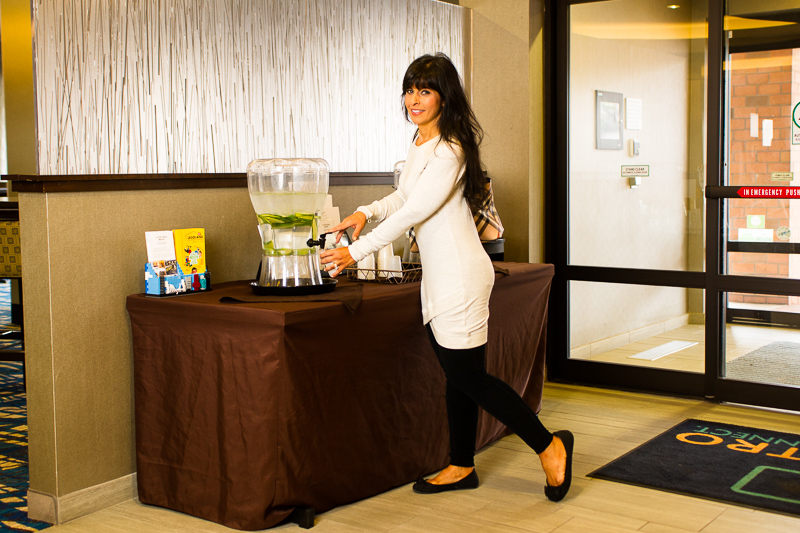
Keep some flavored seltzers on hand for group gatherings where people will expect you to drink with them. If they ask why you’re not drinking, politely tell them you’re giving your brain, liver, and body a break!
Try to include a friend or coworker in the challenge. Having someone to check in with or be accountable to can help with having a successful alcohol free January.
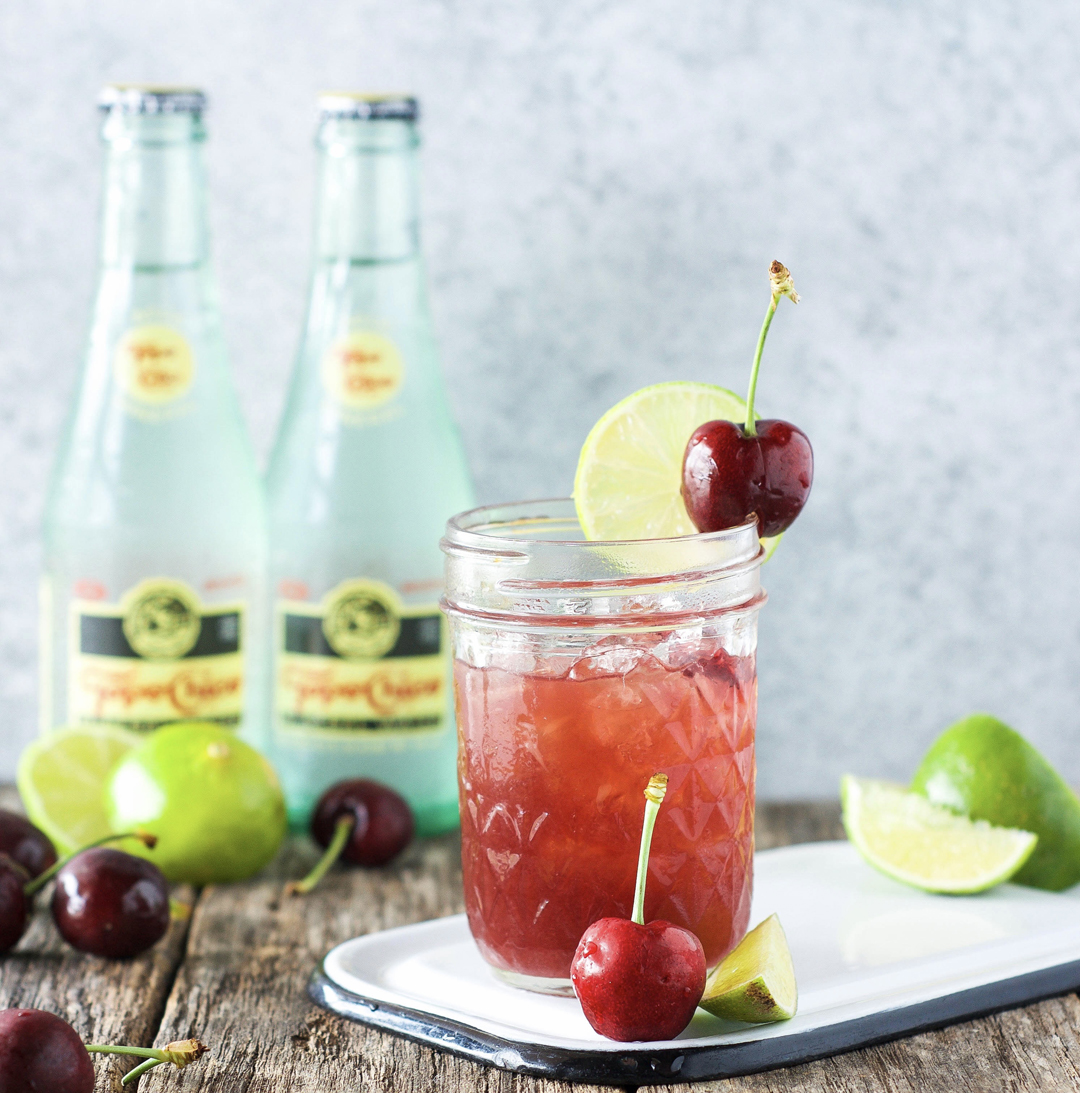
Be prepared by having a list of go to mocktail recipes easily accessible in your kitchen (printed or bookmarked on your phone) and keep your pantry/fridge stocked with mocktail ingredients such as sparking waters, fresh fruit, frozen fruit, fruit juices, or sugar free syrups. Consider trying some fun non-alcoholic beverages such as Olipop, Culture Pop, Ghia, Recess Canned Mocktails, or Kombucha.

Use flavored vinegars for simple DIY mocktails. My favorite is a generous splash of raspberry balsamic vinegar with sparkling water, but the combinations are endless, and it always feels special. Vinegar has been used for centuries in cocktails and drinks called shrubs. The acid in vinegar provides a brightness that’s difficult to replicate, and flavored vinegars are a shortcut to adding rich, layered flavors to mocktails. You can also combine them with fruit juices or tonic water if you prefer more sweetness.
Journaling every day during Dry January can help you tune into your feelings and make you more aware of patterns in your day-to-day life that make you more likely to drink. You can write whatever is on your mind, but I recommend making notes of what is happening in your day, who you’re with, and whatever emotions you’re feeling anytime you get an alcohol craving. This practice can help you cut back not just in January but all year long.
Having a go-to non-alcoholic beverage or mocktail that is fun and enjoyable will set you up for success this Dry January. Plan ahead and bring your own mocktail ingredients or non-alcoholic beverages to a social gathering.
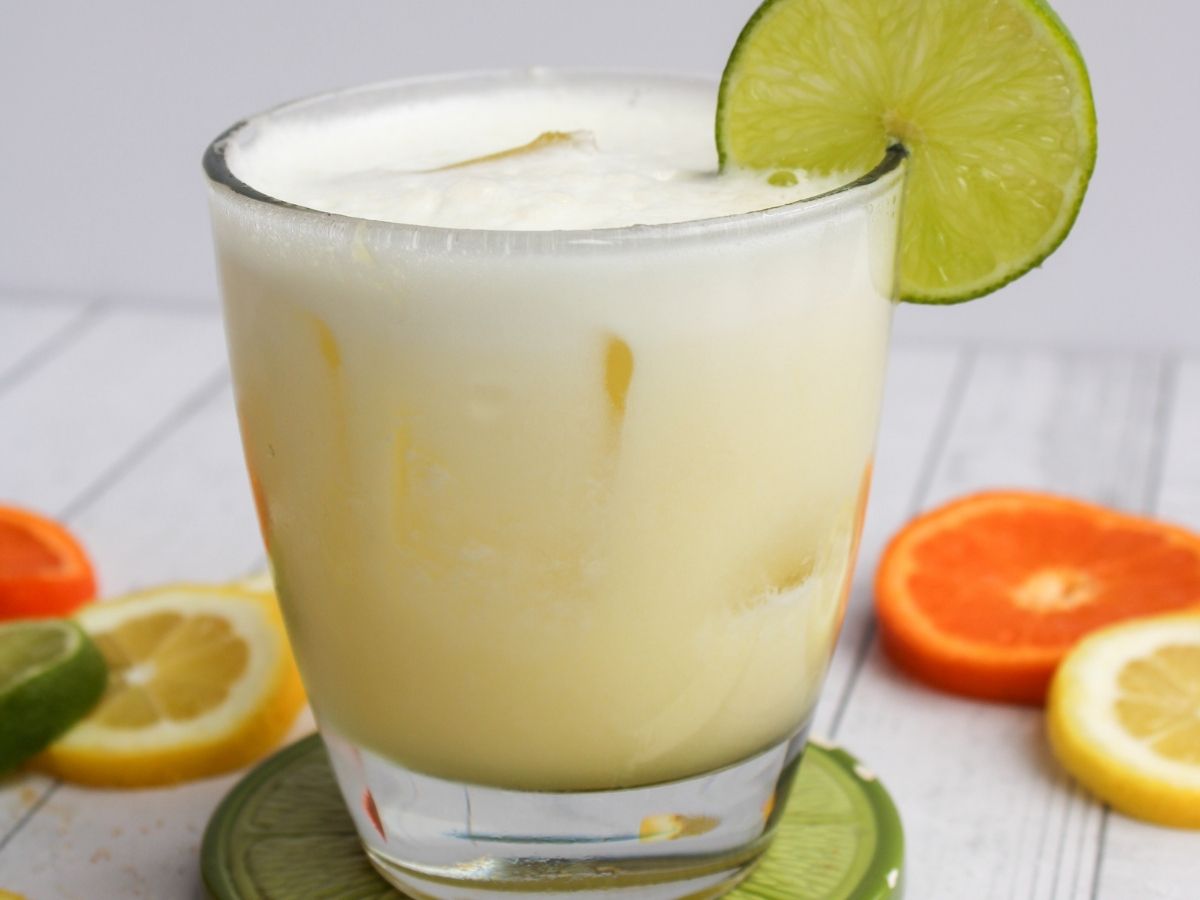
Ingredients:
Instructions
Pour all ingredients into a blender and blend on high for 20 to 30 seconds or until smooth.Pour into a glass over ice and enjoy!
NotesI recommend blending the pineapple chunks (fresh or frozen) but you can easily substitute pineapple juice to make it even easier. You can also substitute lemon juice for lime juice.
Nutrition
Calories: 96kcal | Carbohydrates: 29g | Protein: 2g | Fat: 1g | Saturated Fat: 0.3g | Polyunsaturated Fat: 0.1g | Monounsaturated Fat: 0.03g | Sodium: 773mg | Potassium: 608mg | Fiber: 5g | Sugar: 14g | Vitamin A: 81IU | Vitamin C: 63mg | Calcium: 76mg | Iron: 1mg
Jennifer O’Donnell-Giles, MS RDN specializes in sports dietetics. She’s an athlete herself and has been working with athletes for 26 years helping them nail their nutrition and become faster, stronger, better and healthier athletes! Instagram and TikTok: @JennGilesEat4Sport:
Create a list of relaxing/soothing activities that you enjoy that don’t include pouring a drink. It could be things like drawing a warm Epsom salt bath, lighting a fire in your fireplace and sitting in front of it with someone you love, working on a project like knitting, organizing a closet or redecorating a room, catching up on a favorite streaming series. Committing to projects during the month of January can keep you focused and less likely to drink. Movement is also key! We can challenge our DNA by being consistent with exercise. In addition to your daily workout, you can drop and do pushups when you feel the urge for a drink or take an evening yoga class or grab a headlamp and go on a night walk. New patterns and adventures are exciting! When opting for mocktails I suggest adding 2 tablespoons of juice to seltzer and making fun ice cubes with berries or pomegranates in them to make it look fancy and fun. That way there’s not too many calories or sugar but it feels like a treat.
Alyssa Smolen, MS RDN CDN is a media and community dietitian. Instagram and TikTok: @arugalyssa
Ways to have a successful dry January can include finding other drink alternatives. They don’t have to be mocktails! There are a ton of prebiotic sodas or sparkling waters on the market. A good tip is to pour your drink into a wine glass or a festive cup to simulate having a cocktail.
Umo Callins, MS, RD, CSSD, LD, CPT is a Sports Dietitian and fitness coach. She owns Well Rooted Health and Nutrition and 180Physique offering evidence-based guidance for athletes and active individuals. She is a trusted media expert who is dedicated to making nutrition and fitness simple and accessible to all. Instagram and TikTok: @sassy.sports.dietitian
This delicious, mulled wine-inspired mocktail is packed full of intense fruity flavor and winter spices. New Zealand black currants are packed full of anthocyanins which are a type of antioxidant that helps reduce inflammation and supports your immune system which is beneficial especially during this time of the year. A delicious mocktail with multiple health benefits!

Ingredients (serves 2-3):
Directions:
Alyssa Simpson, RDN, CGN, CLT specializing in gut and digestive health and the host of The Gut. Instagram @nutritionresolution
Keep the social vibe alive by hosting a Dry January-themed gathering where friends bring their favorite non-alcoholic drinks. It’s a great way to discover creative alternatives and stay connected without feeling left out. Building a supportive environment makes it easier to stick to your goals.
Dry January is also a great time to reassess your evening routine—replace that glass of wine with a relaxing ritual like sipping herbal tea and practicing mindfulness. This well-rounded routine helps you wind down naturally, promotes better sleep, and sets a positive tone for the next day. You’ll wake up feeling more refreshed and energized to tackle the day.
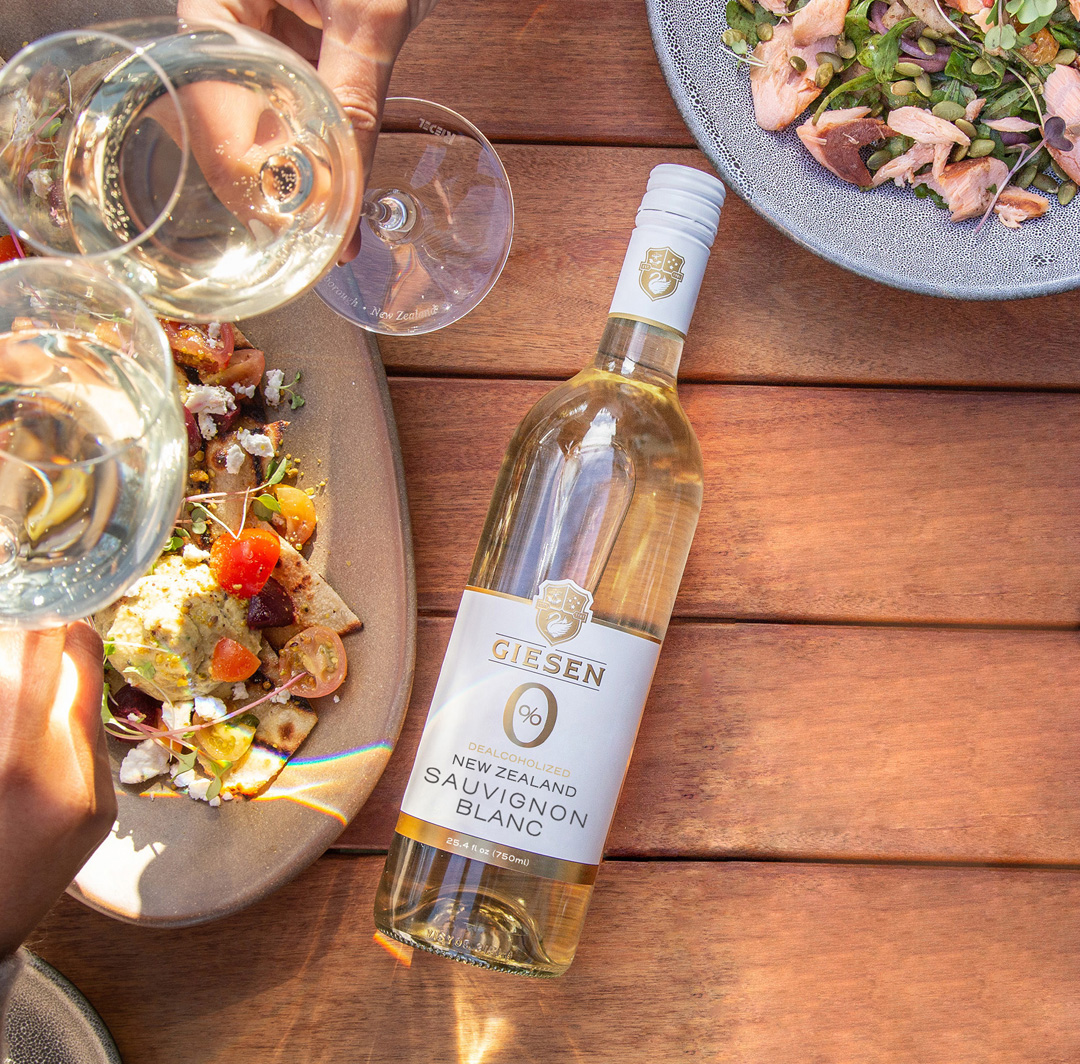
For myself, this is my second-year dancing with the idea of Dry January. I found with all the stress, and hustle and bustle of the holidays, it felt like Wet December. When I was trying to lose weight, it seemed easier to restrict alcohol. Not only do I prefer to eat my calories, but in my experience vodka leads to Oreos. Now that I am in my goal weight range, cocktails, particularly around the holidays, creep their way back in. Some things that help me with Dry January, and throughout the year, is to enjoy what I am drinking. While I often enjoy a splash of cranberry juice and a lime with some sparkling water, when I don’t want sparkling or just plain water, I love drinking Hint Water as it’s fruit-infused without any added sugar, calories or artificial sweeteners and a perfect on the go option. I also experimented with alcohol free wines, and while it took some trial and error, I finally found my favorite in Giesen’s 0% Non-Alcoholic Sauvignon Blanc. Often, no one even knows that I’m not drinking along with them, and I love not feeling groggy or regretful the next morning. So, whether you’re proudly boasting #DryJanuary on your social media for the month or it’s your little secret, giving up the bubbly doesn’t have to be a sacrifice!
About the author: Charlene Bazarian is a fitness and weight loss success story after losing 96 pounds. She mixes her no-nonsense style of fitness advice with humor on her blog at Fbjfit.com and on Facebook at FBJ Fit and Instagram at @FBJFit.
Disclaimer
The Content is not intended to be a substitute for professional medical advice, diagnosis, or treatment. Always seek the advice of your physician or other qualified health provider with any questions you may have regarding a medical condition.
It’s a new year and you know what that means: a ton of messaging about a “new” you. Well, for the record, we think you’re fabulous. (And that color looks great on you, BTW.)
But if you’re looking to fire up your fabulousness or craving a change this year, a vision board may help you achieve your goals. According to therapist Lori Gordon-Michaeli, LCSW, a simple collage of images and inspiring words can be a powerful reminder and motivator for success.
“It’s like a big sticky note saying, “This is my goal. This is what I’m working toward” — because life does have a way of getting in the way of our goals and distracting us. And those distractions can really take us off our path,” she said.
Read: Bye-Bye Excuses: How to Move Forward with Your Health and Fitness Goals >>
As the name implies, a vision board is a collage of images and words on a board that provide a visual reminder of a goal you want to achieve during a set amount of time. Your goal can be something you want to accomplish in 10 weeks or 10 months or 10 years. The key is to be realistic about the goal and the timing.
From personal relationships to career, travel and health goals, your vision board can represent any realistic objective (spoiler alert: adding photos of Channing Tatum probably won’t make him magically appear on your next blind date — but if he does, you’re welcome!) So, grab a stack of last year’s magazines, your scissors and glue stick and get ready to manifest the Tatum out of 2025.
Here are Gordon-Michaeli’s tips for how to make a vision board and make it work for you.
Step 1: Define your goal. You want your goal to be concrete and achievable, which will help set you up for success. If you’re not exactly sure what your goal is, start broad and narrow down your focus. For example, if your goal is to improve your health, how are you going to do that? Maybe that means running a 5K this year.
Step 2: Gather your supplies. Start with a large piece of cardboard or paper that has ample space for you to be creative (think: bigger than a standard piece of paper — but if that’s all you have, go for it. Or use the side of a cardboard box you have lying around.) Gather magazines and glue sticks or tape — whatever you have to secure the images to the board.
Read: What Is Art Therapy and How Can It Help Women? >>
Step 3: Build your board. Your vision board should be something that attracts your eye and your mind, keeps you on point and reminds you of your goal every time you look at it. As you’re gathering images and adding words, ask yourself questions about your goal such as:
It’s important to bring in representation of what success looks like to you. For example, using the 5K again, you can add in an image of a gold medal or the word “victory” to the board.
Step 4: Add sentimental touches. Personal photos of yourself or your family or friends adds another layer of inspiration. These images can represent a happy time or serve as a reminder that you have people cheering you on. Other personal touches like your favorite flower or animal or a favorite saying can also help you connect to your goal.
Step 5: Put the board where you see it often. You want to put your vision board in a place where you can spend a little time in front of it — not just walk past it — like in a home office or the bedroom. Every time you see the vision board, close your eyes and imagine yourself in the place or doing the activity or having the item your board represents.
In addition to manifesting, vision boards also remind you that you have something to look forward to. So, what happens when you reach the goal? Time for a new board! Channing Tatum won’t be single forever.
From Your Site Articles
Related Articles Around the Web
Katharina Bauer born in Wiesbaden, Germany. She is an athlete specializing in the pole vault. She represented her country at the 2019 World Championships in Doha. In addition, she twice reached the final at the European Indoor Championships. Her personal bests in the event are 4.65 meters outdoors (Beckum, Germany) and 4.60 meters indoors (Leverkusen 2015).
Having problems with abnormally fast heartbeat since her youth, she competes with an implantable cardioverter-defibrillator (ICD) in her chest. She is coached by Leszek Klima. She is also as a speaker on mindset and health communication. Despite suffering from heart disease and an implanted defibrillator, she swung as a world-class pole vaulter over heights that would make others dizzy and simply breathed away fears.
Women Fitness President Ms. Namita Nayyar catches up with Katharina Bauer is an exceptionally talented German pole vaulter with defibrillator, here she talks about her fitness routine, her diet, and her success story.
You were born in Wiesbaden, West Germany. Where did you have your early schooling? How and when did you choose Pole Vault as your sport of choice? This later propelled your career to the height where you have been leading women German Pole Vaulters. Tell us more about your professional journey of exceptional hard work, tenacity, and endurance?
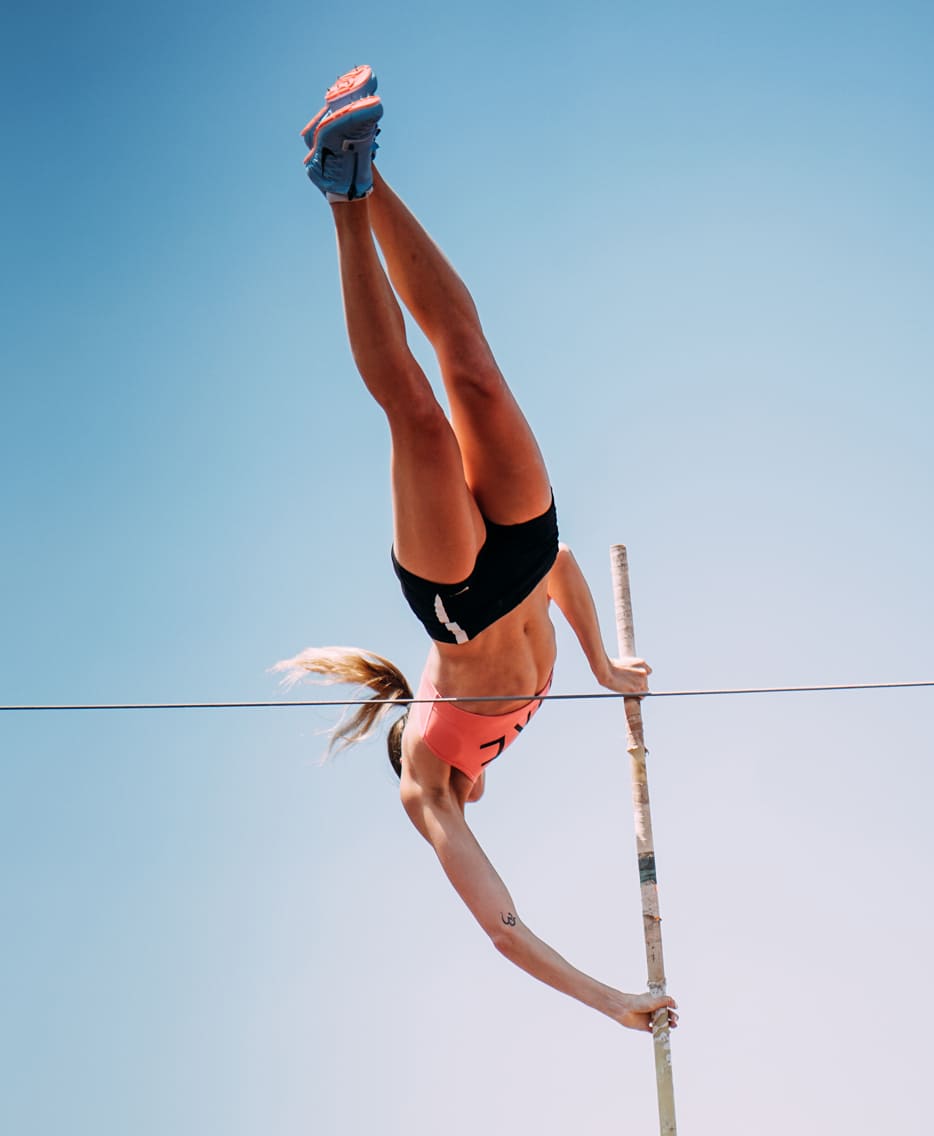
I completed my school education in my hometown of Wiesbaden. After that, I began studying International Management, a distance learning course specifically for top athletes, and successfully completed my Bachelor of Arts in International Management. Sport has always been my passion. I started doing artistic gymnastics at an early age, then athletics at the same time, then a mix of gymnastics and athletics (German 6 -way competition) and finally, at the age of 13, I ended up doing pole vaulting.
The former world-class pole vaulter Carolin Hingst founded a pole vaulting group in Mainz, which I joined. At first I was doubtful, but my mum told me I should just give it a try and, sure enough, I felt a fire of passion blazing up inside me. This enthusiasm has never left me since then. I quickly became very good and jumped 1m higher than my training colleagues in my first competition, which is why the national coach Herbert Czingon took me into his group and led me to my first major success just 2 years later. German Vice Champion Youth with 4.00m. Another change followed to Balian Buschbaum and then I went to Leverkusen to Leszek Klima. I spent 10 years with him and he helped me to my personal best of 4.65m and to various international events and medals.
Professional sport requires a lot of discipline, stamina and endurance. Most spectators who see me jump in a successful competition cannot see behind the scenes. In the glow of success, everything seems like a fairytale, but that is not reality. That is why it is so important to develop a motivational strategy and to pursue it with ambition and full commitment. Tears, injuries and mental turmoil are all part of it. It is then up to you how you deal with it and what you are prepared to give your all for. Ultimately, it is the successful jump, the new personal best and the cheering of people that motivate you to exceed your own expectations. In my opinion, the biggest battle as an individual athlete is with yourself and it is nice to push your own limits and notice how you grow physically, mentally and spiritually through the challenges you face.
It is a dream for a pole vaulter to compete at European Indoor Championships. You twice reached the final at the European Indoor Championships. Tell us more about this spectacular achievement of yours?
It was absolutely amazing to take part in international championships. There is always something special in the air. Be it the gathering of the national team, the clothing, the atmosphere, the exchange with other international athletes and the unforgettable atmosphere. For me, the motto for both European Indoor Championships was: “Make the impossible possible”.
In 2013 in Gothenburg, I had a personal best of 4.45m and that was exactly the height required to reach the final. With so many high-class and experienced competitors, it was impossible for me to master this. However, I was able to surprise myself by going into the competition with inner calm and actually improving my personal best by 1 cm to 4.46m and securing my ticket for the final. In 2016 in Prague, it was a similar situation, only this time it was about the required height of 4.60m, which I had only jumped 2 weeks before. It was the toughest European Indoor Championship qualification that required a final height of 4.60m for several years and I mastered exactly that again. These are two very nice sporting events that I look back on with a smile.
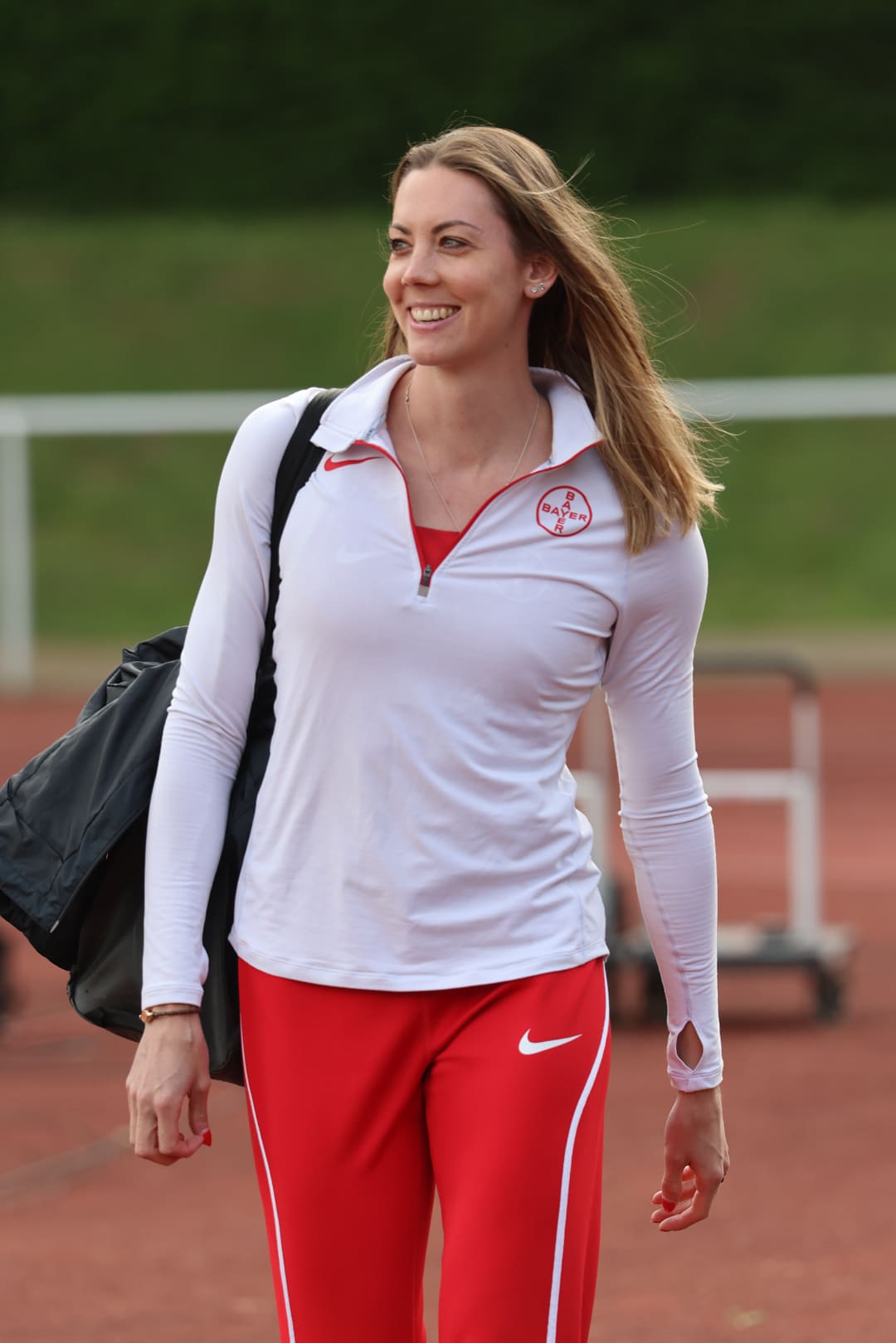
You had Leszek Klima as your Coach who has been a catalyst that helped you pave the way to rise in your career with discipline and a never stopping attitude. Elaborate about his influence on your professional life?
Leszek and I are an inseparable team and I value him very much. Even as a teenager, it was always my dream to train with him and improve my performance. This dream came true in 2013 and lasted 10 years until the end of my career in 2023. What I particularly admire about him is that he finds and paves his own path to success for every athlete. He has a strong vision and is a good driver and motivator. Training demands everything from you and you need that one person who helps you to overcome your fears and grow beyond yourself.
The coach is the biggest reference person throughout your entire career and you see him more than your own family and friends. Daily training, every competition, every training camp. That’s why it’s so important to have a good basis of trust and to form a team. That’s exactly what I found in Leszek – a companion who never left my side and mastered every up and down with me. I am therefore infinitely grateful to him.
Full Interview is Continued on Next Page
This interview is exclusive and taken by Namita Nayyar President of womenfitness.net and should not be reproduced, copied, or hosted in part or full anywhere without express permission.
All Written Content Copyright © 2025 Women Fitness
Disclaimer
The Content is not intended to be a substitute for professional medical advice, diagnosis, or treatment. Always seek the advice of your physician or other qualified health provider with any questions you may have regarding a medical condition.
Treat yourself right by getting
A Mammogram
Takes less time than a mani/pedi — and it can save your life
The 5-year survival rate for localized breast cancer that’s caught early is 99%
Not a massage, but you do sleep through it
The 5-year cervical rate for colon cancer that’s detected early is 90%
An annual checkup
Not as calming as a bubble bath, but it can give you peace of mind
An annual checkup can catch health issues early, when they’re easier to treat
A skin check
Not exactly a facial — but it can save your skin
Melanoma has a 99% 5-year survival rate when it’s caught early
An eye exam
Cucumber slices soothe your eyes, but eye exams save them
You can avoid permanent vision damage if you catch certain eye conditions before they get worse
A dental exam
Laughter is the best medicine — so keep your pearly whites in show-off shape
Good oral hygiene can help prevent infections, bad breath, certain medical conditions and tooth loss
Most preventive care must be covered by insurance. But, if any of these preventive care services aren’t covered by your health insurance, look for free and low-cost services in your area.
By Andrea Lepcio Founder and Owner at Mighty Fit
We sit for work, sit to commute, sit to eat, and sit for fun. We sit a lot.
It was Dr. James Levine, a professor of medicine at the Mayo Clinic, who compared sitting with smoking. His exact phrasing was more graphic, “Sitting is more dangerous than smoking, kills more people than HIV, and is more treacherous than parachuting. We are sitting ourselves to death.“
Dr. Levine is commenting on the undisputed fact that modern life involves much sitting. People who work likely sit for breakfast, commuting, morning work, lunch, afternoon work, returning home, computer use, dinner, reading, television, and hobbies. Retirees do for meals, transportation, computer use, reading, hobbies, and television. Everybody does on the john.
As part of an American Cancer Society’s Cancer Prevention II study in 2010, the American Journal of Epidemiology reported that sitting for more than 6 hours a day increases the risk of death by up to 49%.
In Yoga, we call it chair pose, and in fitness, we call it squatting. If you hinge your hips and bend your knees, you use your leg, core, and back muscles to lower down and rise back up.
Similarly, lowering yourself into a chair and rising back up is relatively active for most people. Notice if you engage your muscles to reach the seat in a smooth motion or if you come partway down and then release your muscles and plop the rest of the way. People with weaker legs and glute muscles will likely hear the sound of landing on a chair. You can work to strengthen your legs and hips to land more smoothly.
Once seated, different habits take form. You can choose to sit more or less actively. Active sitters feature good posture and an engaged core. Most often, both feet are on the floor in front of them. They may sit against the back of the chair or on a backless chair. If perched on a fitness ball, the core will be active front, back, and side to keep balance.
Inactive sitters will relax all muscles and slouch. They may cross their legs at the knee, which impacts circulation and can cause blood clots. Muscles may be stretched or compressed; joints may be impacted, blood pressure increases and numbness may occur in the lower leg.
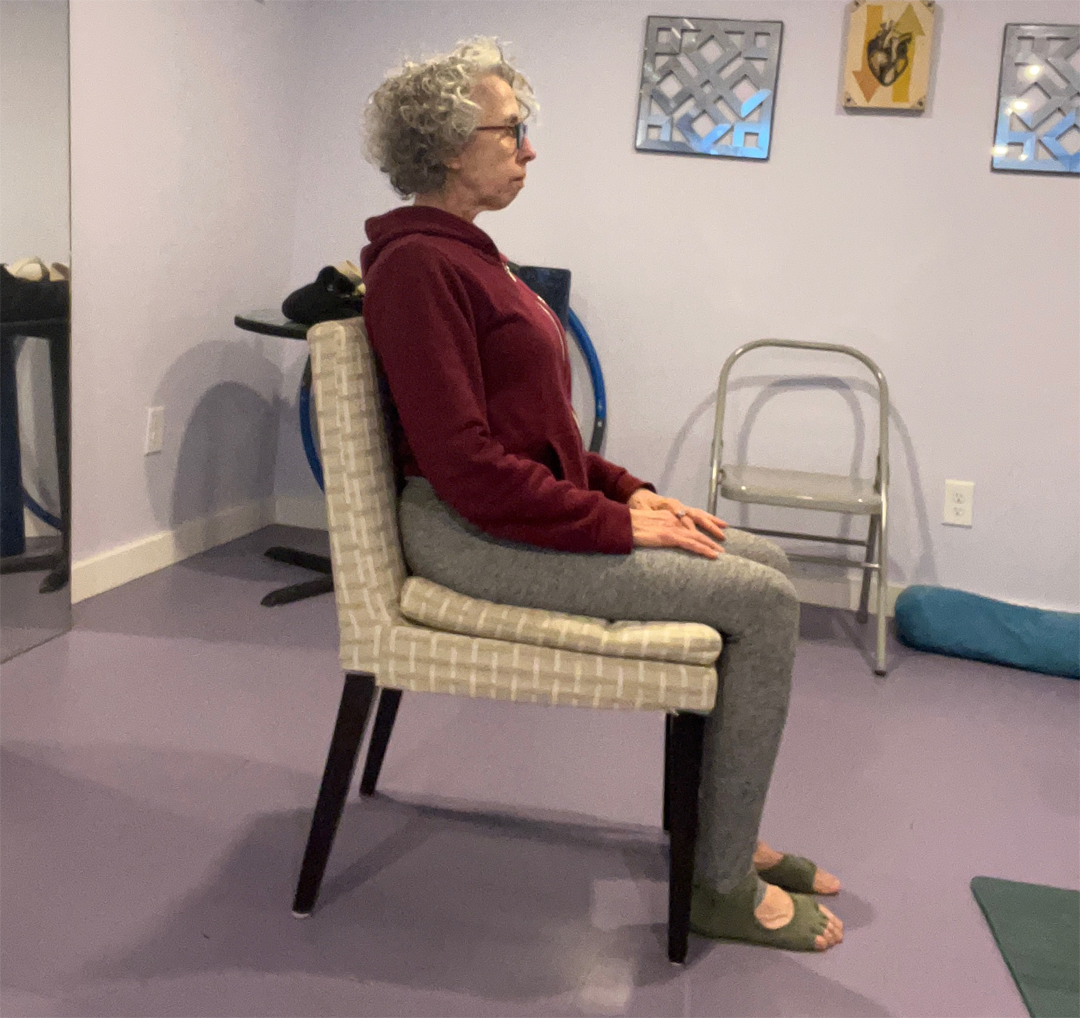
It is common for arm bones to slide forward as the upper back curves. The chest, trapezius, and neck muscles tighten and shorten while the mid and lower-back muscles lengthen and weaken. Sometimes, people allow their heads to drift toward a computer or screen. This forward head position puts pressure on neck muscles as the head becomes heavier the further forward it reaches.
If you sit for several hours without getting up:
These effects will influence those who sit inactively the most. The severity will depend on how long and how you sit. Dr. Levine’s research confirms that even if you exercise, sitting for hours a day can have a negative effect that exercise doesn’t counteract.
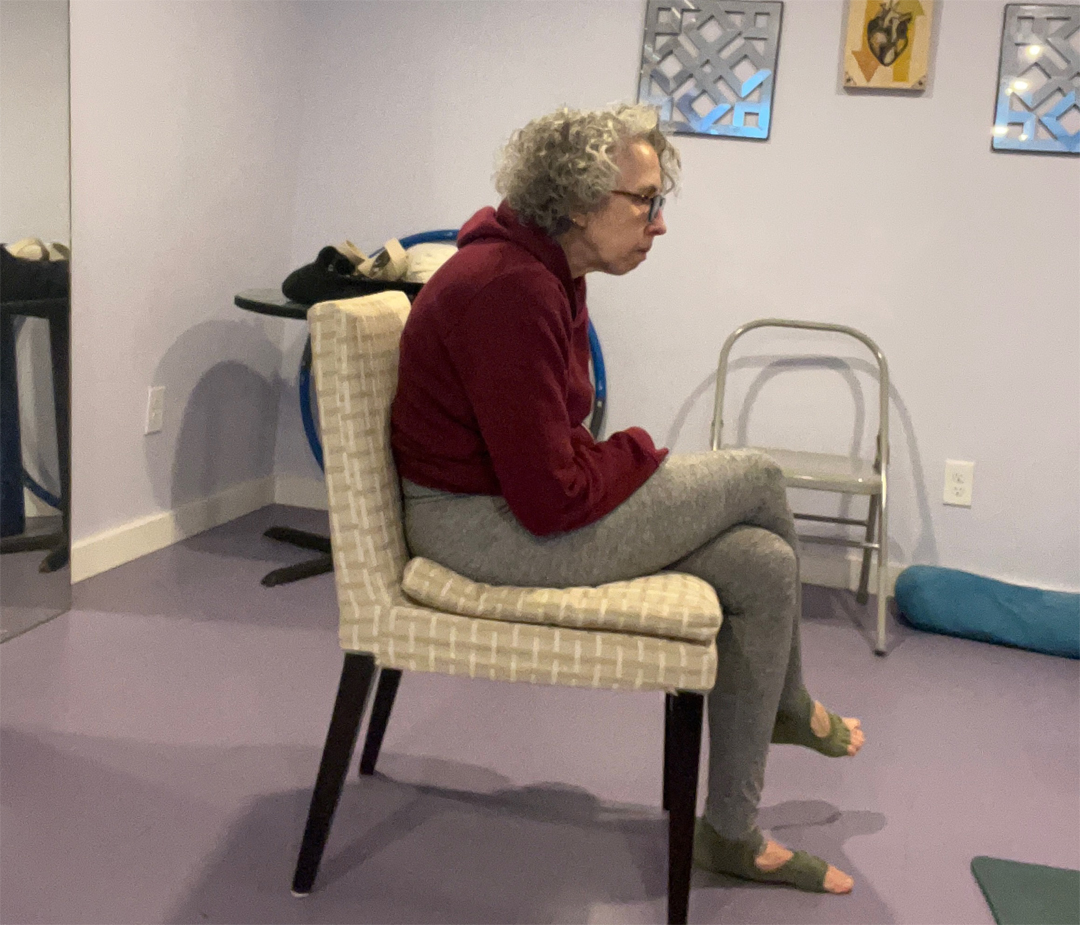
Note that some people are at risk for diseases separate from their sitting habits. Researchers identify the following risks from excessive sitting:
What does sitting have to do with cancer risk? The Cleveland Clinic explains, “Research shows that sitting for long periods during the day increases your chance of developing certain types of cancer, including:

The Heart Foundation states, “A 2011 study documented 800,000 people and their sitting habits. The study found that people who sit the most, compared to people who sit the least, have a greater risk of disease and death:
Once upon a time, cigarette ads showed doctors enjoying cigarettes. According to Yale University Library, “Cigarette companies often advertised smoking as a way to stay happy and healthy.” Whether or not you were a smoker, you inhaled smoke in public spaces and homes. It wasn’t until 2000 that smoking was entirely banned on airlines. Smoking was considered normal, and it took decades for the risks to become publicly accepted.
Sitting for hours a day is so ordinary that it is also considered normal by most people. However, the health risks of this habit have only recently come to light.
The health damage from smoking is costly: according to the Centers for Disease Control and Prevention, smoking causes 480,000 deaths per year and costs over $300 billion.

The CDC reports statistics for sedentary behavior and physical inactivity that goes beyond sitting: The direct healthcare costs in the United States are $117 billion annually, with approximately 300,000 deaths per year.
Smoking does greater damage, but the number of people who sit for long periods far exceeds those who smoke.
Researchers with the American Journal of Public Health are insulted by the analogy between sitting and smoking. They feel it makes smoking seem less harmful, and tests have not proven the risks of sitting to be as drastic as the risks of smoking.
There are plenty of bad health decisions to choose from. Smoking and drinking top the list. Poor nutrition, lack of hydration, bad posture, overworking, high stress, insufficient sleep, and an unhealthy environment are harmful.
Sitting is an essentially unavoidable health factor. Even active people sit for some portion of their day. Smoking is a choice; sitting is a necessity.
Three dynamics magnify the health implications: the number of hours one sits, how actively or inactively one sits, and how inactive one is outside of sitting.

Awareness of the problem can help with mitigation. If you know you sit for hours, you can make choices to lessen the impact on your health.
As mentioned, exercise isn’t enough to counteract sitting. If you have the good habit of getting a minimum of 150 minutes of moderate exercise per week, you will still improve your health outcomes if you take advantage of these recommendations to break up your time when sitting.
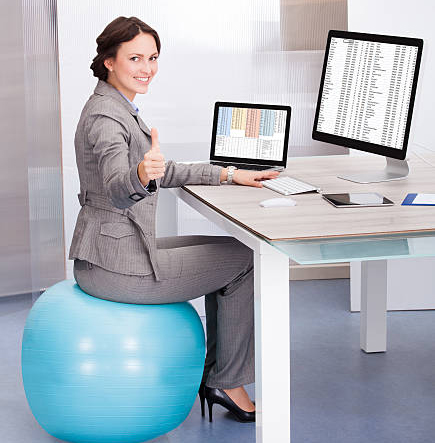
I am a personal trainer who works out for at least two hours each day. Nonetheless, I alternate between a standing desk and sitting on a fitness ball. I limit my time in chairs to under three hours, sit actively, and get up and down frequently.
The good news is that individuals can make changes to benefit their health. Interrupting sitting time with movement, exercise, or, at a minimum, standing will improve outcomes. Adding a regular exercise program will help prevent a host of diseases. Whether you are 20 or 80, these changes will help you maintain your health.
Disclaimer
The Content is not intended to be a substitute for professional medical advice, diagnosis, or treatment. Always seek the advice of your physician or other qualified health provider with any questions you may have regarding a medical condition.
This holiday season, you’re probably busy getting gifts for all the important people in your life. But I bet I can think of someone you left off your list.
Yourself.
We often find ourselves caring for everyone else and putting ourselves last. This year, I’d like you to take some time to think about yourself. I know that might make you uncomfortable because you may not be used to putting yourself first. But you deserve it. Trust me, you do.
Since you probably didn’t put yourself on your own list, I’ve got you on mine. This year, I’d like to give you a gift: The permission to add some TLC for yourself to the long list of things to do for everyone else that you face every day and, in particular, during the holidays.
As you make your to-do list full of tasks and traditions, remember to add a visit to your favorite bakery for a pumpkin muffin, to schedule a massage, or even to just get in bed early and curl up with your favorite book.
The holidays will still happen, whether you stress about them or not. So take a beat, relax — and remember that
taking care of yourself should be a priority for 2025.
Warm and healthy wishes always,
“Ya no se recomiendan los autoexámenes de las mamas”.
Cuando leí ese título hace unos meses, pensé que fue un error tipográfico. Puesto que encontré una masa cancerosa en mi mama la cual resultó ser cáncer de etapa 3, me sorprendió enterarme que muchas organizaciones médicas tales como la Sociedad estadounidense contra el cáncer y el Instituto nacional de cáncer ya no recomiendan autoexamenes de las mamas. Y no se recomiendan desde hace años.
¿Qué pasó?
Los autoexámenes de mama se implementaron en la década de los cincuentas como una forma conveniente y barata para que la gente detecte el cáncer de mama en forma temprana, cuando puede tratarse más. Pero poco después del año 2000, investigaciones descubrieron que realizar autoexámenes formales de las mamas (levantar tus brazos, acostarte, movimientos circulares, etcétera) no reduce tu riesgo de morir de cáncer de mama. Un metaanálisis que comparó a mujeres que realizaban autoexámenes mamarios de rutina con mujeres que no las realizaban determinó que no había ninguna diferencia en sus tasas de supervivencia de cáncer de mama. Pero las personas que se examinaron las mamas tuvieron más resultados positivos falsos y casi el doble de biopsias de mama sin cáncer.
Lee: Lo que debes saber sobre las biopsias de mama >>
Sin datos que demuestren que los autoexámenes de mama pueden reducir el riesgo de morir de cáncer de mama, y la posibilidad de lesiones debido a pruebas innecesarias, ya no se recomiendan los autoexámenes de mama para personas con riesgo promedio según la mayoría de organizaciones profesionales y proveedores de atención médica (riesgo promedio significa que no tienes antecedentes personales ni familiares ni mutaciones genéticas, tales como BRCA1 o BRCA2).
Larry Norton, M.D., un oncólogo médico de las mamas de Sloan Kettering Cancer Center, dijo que el cambio de pauta por la cual ya no se recomiendan los autoexámenes de mama no significa que deberías dejar de poner atención a tus mamas. Eso se denomina autoconciencia mamaria.
La autoconciencia mamaria es conocer cómo se ven y se sienten tus mamas para que puedas identificar cualquier cambio. “La falta de autoconciencia de lo que es saludable en tu cuerpo podría evitar que identifiques algo que no se encuentre del todo bien”, dijo Norton. “Es muy bueno tener ese conocimiento y encontrar algo diferente en tu cuerpo, independientemente de lo que sea, para ponerle atención”.
A diferencia de los autoexámenes de mama, no hay un cronograma o técnica para la autoconciencia mamaria, es básicamente usar tus ojos y manos para saber que es normal en ti. Las señales de cáncer de mama a las que deberías poner atención incluyen:
Norton dijo que cambios de la apariencia y secreciones de los pezones son más obvias, pero saber cómo se siente tu mama es importante porque podrías notar señales de cáncer de mama que tu proveedor médico o pruebas de imagenología podrían no detectar. “Cuando tocas tu mama y sientes un lugar inusualmente duro o un lugar inusual que duele y que no solía doler antes, esas son cosas que son un poquito más sutiles”, dijo Norton.
Aunque la mayoría de proveedores de atención médica recomiendan la autoconciencia por sobre los autoexámenes, algunas personas podrían desear seguir la técnica y rutina estándar. Si examinas tus mamas, lo mejor es hacerlo de tres a cinco días después de que termina tu período menstrual, cuando tus mamas son menos sensibles o están menos abultadas. Si eres posmenopáusica, haz la autoexamen el mismo día de cada mes.
Lee: Cómo auto – examinar tus mamas >>
Los riesgos asociados con autoexámenes formales de mama incluyen resultados positivos falsos y biopsias innecesarias de tejido que no es canceroso. Investigadores dicen que el estrés mental y financiero de las imagenologías y biopsias también explica parcialmente el razonamiento contra los autoexámenes formales de mama. Sin embargo, es importante indicar que los resultados positivos falsos son frecuentes y que las probabilidades de tenerlos aumentan con la edad. Preocupaciones relacionadas con los resultados positivos falsos no deberían impedir que pongas atención a tu salud mamaria y que contactes a tu proveedor de atención médica si ves o sientes algo inusual en ti.
Norton dijo que estar familiarizada con tus mamas para notar cambios es la lección importante de los autoexámenes . Pero ni la autoconciencia mamaria ni los autoexámenes son un sustituto de las mamografías en lo que se refiere a las examinaciones de cáncer de mama.
Actualmente, las mamografías son el estándar dorado de examinaciones de cáncer de mama. Según las pautas más recientes del Equipo de trabajo de servicios preventivos de EE.UU. (USPSTF, por sus siglas en inglés), las personas que tienen un riesgo promedio deberían empezar a someterse a mamografías a los 40 años y no a los 50 como se recomendaba previamente. El cambio refleja los datos recientes que muestran que uno de cada 6 cánceres nuevos de mama se desarrolla en personas de 40 a 49 años y eso concuerda con otras organizaciones que ofrecen pautas de examinación.
Las recomendaciones de con qué frecuencia someterse a examinaciones varía para cada organización, con algunas indicando que deben hacerse cada año y otras cada uno o dos años. Deberías hablar con tu proveedor de atención médica sobre qué medidas tienen sentido según tus circunstancias.
Independientemente de las pautas, Norton dijo que si sientes o ves algo sospechoso, comunícate con tu proveedor de atención médica inmediatamente. “Me gustaría decir que tu cuerpo ha sido confiado a ti y deberías hacer lo que sea necesario para honrar esa confianza y una de esas cosas es las examinaciones y otra es conocer tu cuerpo. Así que si algo es anormal, no lo ignores”.
Este recurso educativo se preparó con el apoyo de Daiichi Sankyo y Merck.
From Your Site Articles
Related Articles Around the Web